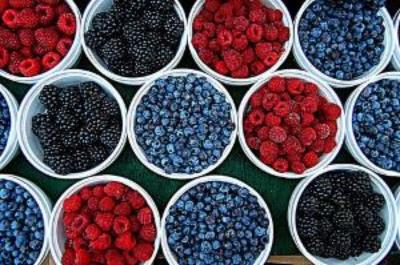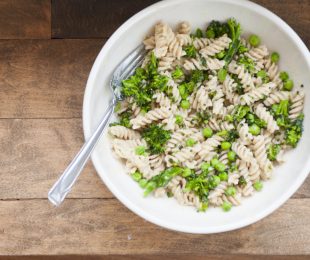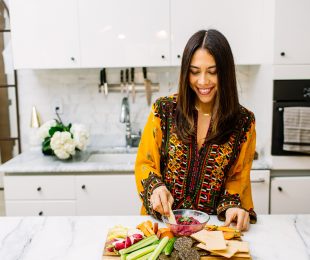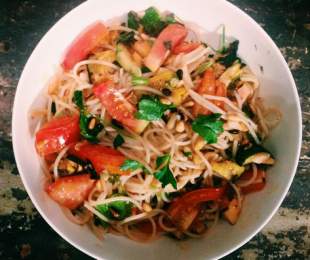OK, WE KNOW WHAT YOU’RE THINKING. I know what I can’t eat. But what can I eat? “We always try to have alkaline food,” says Gil Jacobs. “You don’t have to eliminate the protein but you need to buffer it with alkaline vegetables and salads.” The number one rule? Don’t mix proteins and starches because they digest in different points in the digestive system. Sound impossible? Here we broke down Jacobs’ guidelines from breakfast to dinner. (Note: This is not for people with aliments. Please consult your physician before trying this diet.)
By Gil Jacobs as told to Nicole Berrie
Photographer Libby Gray
BREAKFAST
“Have fruits in the morning,” says Jacobs. Think apples, berries, grapefruits etc. If you’re extra hungry, Jacobs recommends adding some avocado. As far as bananas, “If you are going to include bananas always make sure the bananas have freckles they should never be all yellow with green tips.”*

LUNCH
“We always begin lunch and dinner with a green salad,” says Jacobs. “Salads mean leaves and shoots. Leaves are obvious and shoots means things that pop up out of the ground.” Our favorites? Romaine lettuce, baby spinach, bell peppers, cucumbers celery, fennel, grated beets, carrots, radishes, the list goes on! We love to add onions and garlic as well. “If your blood pressure is low do not do raw garlic, onions or leeks,” advises Jacobs. “They lower your blood pressure.” For dressing, Jacobs recommends a little olive oil or coconut oil along with lime or lemon juice and a dash of natural aged Tamari soy sauce or Bragg’s Liquid Aminos.**
After the salad, you can follow with a non-protein complex carb lunch. Think: Baked potatoes, cooked broccoli, spaghetti squash, yams or steamed greens with brown rice or whole grain breads with vegetable soup.*** “Soybean food, especially for women, should be avoided,” warns Jacobs. “They are extremely destructive to the thyroid and destructively acidic. Fake meat, fake bacon, soy milk, soy cheese, tempeh are not health food.”

DINNER
“Dinner should be a salad with a protein (fish, free range chicken, grass fed land animals) and cooked vegetables that are not starch,” says Jacobs. For meats, focus on grass-fed and hormone/antibiotic free. “We do salad/protein evening and salad/starch in the midday because starch leaves the stomach easier than protein and if we put the slow digesting food in the middle of the day. When we sit down for dinner and run the risk of the stomach not being empty, then the meal hits a full stomach and ferments, which is aging.” For vegetarians, Jacobs recommends salad and then a starch such as millet croquettes, soba noodles or whole grain pasta with vegetables.

A FEW WORDS ON…
Beverages:
If we are drinking liquids, we sip water while we eat, that’s all. After meals try not to drink. A few hours later drink water.
Sleeping and eating:
You should eat at least 2 hours before you sleep. If you eat at 7:30 and then sleep at midnight, you’re cool. No one should be eating and then sleeping right away.
Cheating:
It’s ok! “Just make sure you do it after dinner because whatever the cheating food is you wont be able to put anything on top of it since it’s processed so slowly. So wait until the evening, have a big green salad and then your pepperoni pizza or layer cake. Do it after a dinner salad. Go love your life don’t feel guilty. Don’t judge. Just get up the next day and get back on the train.”
*“Bananas are a starch, if the fruit sugar isn’t developed it’s like eating raw bread dough. It’s acidic and will stick. A lot of American people think bananas are constipating but they are not, they are only constipating when they are not ripe. When they are ripe they become mildly cleansing so they are a good transitional fruit.
**“Regular vinegar dries up the blood and is hyper acidic. At the beginning apple cider vinegar or balsamic is ok but it’s something that eventually with time you try to pull off. It also mixes terribly with carbs because it is a high acid.
***In a whole grain vegetable meal we do not include lentils, kidney beans, or any of that because legume are a protein. They are heavy protein and heavy starch beans, which is why they make people have gas because they are a mixture of two food groups that can’t be eaten together.

TO READ MORE FROM GIL JACOBS, CLICK HERE





147 Comments